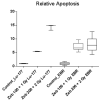Zebularine significantly sensitises MEC1 cells to external irradiation and radiopharmaceutical therapy when administered sequentially in vitro
- PMID: 24323360
- PMCID: PMC3947096
- DOI: 10.1002/cbin.10215
Zebularine significantly sensitises MEC1 cells to external irradiation and radiopharmaceutical therapy when administered sequentially in vitro
Abstract
Zebularine is a cytidine analogue incorporated into DNA during replication, inhibiting DNA methyltransferase 1 (DNMT1), resulting in demethylation and changes in gene expression. Such modification may improve radiosensitivity in resistant lymphoma cells. The hypothesis of this study was that zebularine and radiation would synergistically inhibit cell growth and viability. Human MEC1 malignant B cells were incubated with 0-200 µM zebularine for 48 h. Media containing zebularine was removed, and the cells were irradiated with 0-2 Gy of either external beam irradiation or (177) Lu-DOTA-TATE, a radiolabelled somatostatin analogue. Concentration and viability were measured over 48-72 h. The proportion of apoptotic cells was identified using an active Caspase 3/7 assay. Zebularine inhibited growth of cells in a dose-dependent manner during exposure. No residual growth inhibition occurred following removal of the drug. Zebularine and external irradiation inhibited cell proliferation in a dose-dependent, synergistic interaction, but the effect on viability was additive. Treatment with zebularine and (177) Lu-DOTA-TATE resulted in less inhibition of proliferation (P = 0.0135), but a synergistic decrease in viability. Apoptotic fraction was much higher in cells irradiated with (177) Lu-DOTA-TATE than external irradiation. External irradiation induces growth arrest rather than apoptosis. Apoptosis is the primary effect of radiopharmaceutical therapy on tumour cells. Treatment with the methylation inhibitor, zebularine, appears to synergistically augment these natural effects in vitro, which could be exploited clinically.
Keywords: demethylation; lymphoma; radiopharmaceuticals; radiosensitivity; somatostatin analogue.
© 2013 International Federation for Cell Biology.
Conflict of interest statement
Figures








Similar articles
-
DNA methyltransferase inhibitor, zebularine, delays tumor growth and induces apoptosis in a genetically engineered mouse model of breast cancer.Mol Cancer Ther. 2012 Feb;11(2):370-82. doi: 10.1158/1535-7163.MCT-11-0458. Epub 2011 Dec 27. Mol Cancer Ther. 2012. PMID: 22203734 Free PMC article.
-
Zebularine enhances apoptosis of human osteosarcoma cells by suppressing methylation of ARHI.Cancer Sci. 2016 Dec;107(12):1851-1857. doi: 10.1111/cas.13088. Epub 2016 Dec 19. Cancer Sci. 2016. Retraction in: Cancer Sci. 2024 Dec;115(12):4080. doi: 10.1111/cas.16346. PMID: 27685841 Free PMC article. Retracted.
-
Effects of a novel DNA methyltransferase inhibitor Zebularine on human lens epithelial cells.Mol Vis. 2012;18:22-8. Epub 2012 Jan 10. Mol Vis. 2012. PMID: 22259221 Free PMC article.
-
Mechanism of inhibition of DNA methyltransferases by cytidine analogs in cancer therapy.Cancer Biol Ther. 2004 Nov;3(11):1062-8. doi: 10.4161/cbt.3.11.1308. Epub 2004 Nov 12. Cancer Biol Ther. 2004. PMID: 15539938 Review.
-
Zebularine: a unique molecule for an epigenetically based strategy in cancer chemotherapy. The magic of its chemistry and biology.Nucleosides Nucleotides Nucleic Acids. 2005;24(5-7):305-18. doi: 10.1081/ncn-200059765. Nucleosides Nucleotides Nucleic Acids. 2005. PMID: 16247946 Review.
Cited by
-
Exploring Therapeutic Avenues in Lung Cancer: The Epigenetic Perspective.Cancers (Basel). 2023 Nov 13;15(22):5394. doi: 10.3390/cancers15225394. Cancers (Basel). 2023. PMID: 38001653 Free PMC article. Review.
-
6-Thioguanine and zebularine down-regulate DNMT1 and globally demethylate canine malignant lymphoid cells.BMC Vet Res. 2014 Dec 6;10:290. doi: 10.1186/s12917-014-0290-8. BMC Vet Res. 2014. PMID: 25480665 Free PMC article.
References
-
- Balch C, Yan P, Craft T, Young S, Skalnik DG, Huang TH, Nephew KP. Antimitogenic and chemosensitizing effects of the methylation inhibitor zebularine in ovarian cancer. Mol Cancer Ther. 2005;4:1505–1514. - PubMed
-
- Balkin ER, Jia F, Miller WH, Lewis MR. In vitro evaluation of targeted antisense 177Lu radiotherapy. Anticancer Res. 2011;31:3143–3149. - PubMed
-
- Cheng JC, Matsen CB, Gonzales FA, Ye W, Greer S, Marquez VE, Jones PA, Selker EU. Inhibition of DNA methylation and reactivation of silenced genes by zebularine. J Natl Cancer Inst. 2003;95:399–409. - PubMed
-
- Cheng JC, Yoo CB, Weisenberger DJ, Chuang J, Wozniak C, Liang G, Marquez VE, Greer S, Orntoft TF, Thykjaer T, Jones PA. Preferential response of cancer cells to zebularine. Cancer Cell. 2004;6:151–158. - PubMed
-
- Cheson BD. The role of radioimmunotherapy with yttrium-90 ibritumomab tiuxetan in the treatment of non-Hodgkin lymphoma. BioDrugs. 2005;19:309–322. - PubMed
Publication types
MeSH terms
Substances
Grants and funding
LinkOut - more resources
Full Text Sources
Other Literature Sources
Research Materials
Miscellaneous

